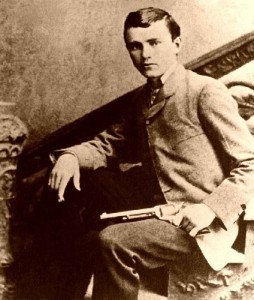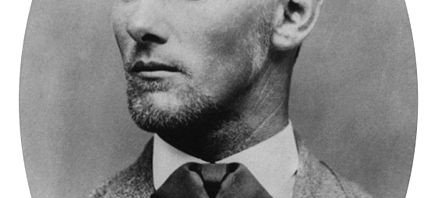There may have been no other train and bank robber in the 1800’s who was sought more than Jesse James. In fact, at one time he most likely was at the very top of the Pinkerton National Detective Agency wanted .
Thank you for reading this post, don't forget to subscribe!The Pinkerton National Detective Agency started in business in the 1850’s and during the American Civil War was quite active on the Union side in the capacities of both protection and spying. On the other hand, Jesse James and his cohorts were very active for the Confederacy. His cohorts included such infamous names as William Quantrill and his Quantrill’s Raiders who raised havoc with killings and massacres in the volatile Missouri and Kansas area. Also included with this group of irregular Confederate guerrillas was Bloody Bill Anderson who branched off with his own group and did much the same as Quantrill.

When the Civil War ended in 1865, there remained strong differences that lasted for some time. The popular story of Jesse James was that his rampage of train and bank robberies after the war was his way of continuing the southern resistance. The James and Younger gang members were acquaintances from the Civil War with strong Confederate beliefs. A lot of this thinking was stoked by sensational newspaper and magazine stories which painted the outlaw as a crusader. Some people looked at it this way. The banks and railroads were extensions of the Union.They were the establishment. Attacking them was, in a way, attacking the Union. This thinking prevailed in many quarters even though the Confederacy was gone.
It appears that the number one apologist for the James gangs crimes was an editor at the Kansas City Times by the name of John Newman Edwards. Edwards, originally from Virginia, was a southern sympathizer both during and after the war. From his Kansas City desk, Edwards clear objective was to instill pride in ex-Confederates and help orchestrate their return to political power. In his effort to accomplish this he lionization Jesse James within his articles and editorials. This is thought to be where the Jesse James as “Robin Hood” myth began. I have never read any stories of the James and or Younger gangs giving out any of their monetary spoils to anyone but themselves. The Robin Hood comparison may have been from the mind of an author or news editor. The myth about James played well to large numbers of people from Missouri and Kansas since that area had a good number of ex-Confederates living there.

The Pinkertons place in all this was that they were under contract from both the railroads and bank associations to apprehend the outlaws. This included James, Sam Bass, Butch Cassidy and several others. While the Pinkertons often worked in concert with whatever law enforcement group had jurisdiction, this was also an era where detective agencies like the Pinkertons operated as a type of unofficial police force. They were known to take matters in their own hands if need be. There has been a lot written about the Pinkertons and their work on behalf of big business. They were frequently hired by big business interests between the 1870’s and early 1900’s to counter and or prevent labor strike violence. There were other private detective agencies also involved in this type of work.
It is believed that the first robbery by the James Younger gang occurred on February 13, 1866 when $60,000 was stolen from the Clay County Savings Association in Liberty Missouri. This was also chronicled as the first daylight bank robbery during peacetime. A seventeen year old boy was accidentally shot and killed during the gangs escape.
Two of the most reported on crimes involving Jesse James was the attempt to rob the Northfield Minnesota Bank and later in his criminal career, the Blue Cut train robbery near Independence Missouri.

The Northfield bank robbery failed. It seems that the town was aware that a bank robbeyr attempt would take place and armed and prepared a defense. This was of course unknown to the James gang which included the Younger brothers. The bank robbery attempt took place on September 6th, 1876 ( just a little over two months after Custer’s defeat at the Battle of the Little Bighorn ). The bank targeted was the First National Bank of Northfield. The robbery was a complete failure. A firefight ensued with the towns people and the robbery was thwarted. Jesse James and his brother Frank barely escaped. The remainder of the gang ( Younger Gang ) were either killed or captured. During the robbery attempt a bank employee and bystander were killed. Cole Younger spent many years in a Minnesota prison.
The one sure thing about the Pinkertons was that once they got on your trail they didn’t let up. They were well known for this and the outlaws knew it as well. Pinkerton agents traced James and many times would be seen in towns where James had recently been to. This was the major reason that at the end of James life he was living under the assumed name of Thomas Howard. The banks and the railroads had a large bounty on his head and the Pinkertons, including Alan Pinkerton himself, was putting more and more pressure on Jesse James. There was one incident where the suspected home of Jesse James was firebombed in an effort to either capture or kill him. The tale was that the Pinkertons were heavily involved in the attack. In fact, it’s been written that Allan Pinkerton took a keen interest in the James gang as a personal vendetta of sorts. This may have been because the gang had eluded the Pinkertons for so long. The attack occurred on January 25, 1875 at the James farm. An incendiary device that was thrown inside by the Pinkerton detectives exploded. The bomb killed James’s young half-brother and blew off one of James’s mother’s arms. After the incident, Allan Pinkerton denied that the raid’s intent was to burn the house down. Apparently the Pinkertons were given some tips beforehand by Union loyalists who resided near the farm. Jesse James was not at the farm at the time.

The last crime that Jesse James was involved with was the robbery of a Chicago and Alton Railroad train in Blue Cut Missouri. Blue Cut is an area very near to Independence Missouri where the trains slowed down at the curve making them more vulnerable to robbery. The Blue Cut robbery stepped up the efforts to capture or kill James and the bounty on his head was increased.
As portrayed in the recent movie regarding Jesse James and his death, he was shot from behind in 1882 at his home by Robert Ford, a member of his gang involved in the Blue Cut train robbery. To this day there are conspiracy theorists who contend that Jesse James faked his own death and lived a long life. DNA evidence on the exhumed remains in 1995 say otherwise. There also was a man who died in Granbury Texas near Fort Worth in 1951 who, at the alleged age of 104 and on his deathbed, claimed to be Jesse James. An exhumation took place by court order on his remains in the year 2000 . DNA tests in 2000 did not match to the DNA taken from an alleged James relative. Granbury believers say there are photos and artifacts that back up their claims. They also say that their Jesse James had a grandson who was a dead ringer for the outlaw. The people of Kearney Missouri where the other Jesse James ( according to DNA testing the real Jesse James) is buried totally discount the Granbury Texas assertions.
While the Jesse James debate continues into the 21st century, today, the Pinkerton National Detective Agency is called Pinkerton Consulting and Investigations, and is a subsidiary of Securitas AB, headquartered in Stockholm Sweden.
For those traveling to St. Joseph Missouri, there is the Jesse James Home Museum displayed on the grounds of the Patee House at12th and Mitchell. This is only two blocks away from the homes original location. There is also the Jesse James Farm located on Jesse James Farm Road Kearney, MO.
(Photos shown are in the public domain)

